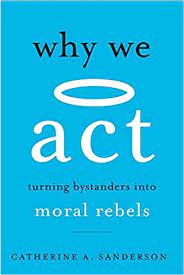Author: Catherine A. Sanderson, PhD
ISBN: 9780674241831
APA Style Citation
Sanderson, C. A. (2020). Why we act: turning bystanders into moral rebels. Belknap Press Harvard University.
Buy This Book
https://www.amazon.com/Why-We-Act-Turning-Bystanders/dp/0674241835
| activity_why_we_act.pdf |
Author Catherine Sanderson, Chair of Psychology at Amherst College, has published over 25 journal articles, several trade books, four university-level textbooks, as well as textbooks for middle and high school students. Her research has received funding from the National Science Foundation and National Institute of Health for her work on topics ranging from social norms, health, parenting, bystander apathy, heroism, health, and longevity.
In Why We Act, Sanderson explores the various factors that explain why good individuals engage in bad behavior, fail to act when faced with the bad behavior of others, and how this inaction leads to more bad behavior. She explores bad behavior, including bullying in school and unethical workplace behavior, corporate fraud, political corruption, sexual harassment, and the inaction of bystanders. Her book also explores individuals who are more likely to act, who she calls moral rebels, and what we can learn from their examples.
In Part 1, The Silence of Good People the book explores what Sanderson calls the myth of monsters and the various reasons good people engage in bad behavior or fail to intervene. She combines classic research in social psychology (e.g., Philip Zimbardo, Stanley Milgram) and modern neuroscience research to explore the impact of deindividuation, obedience to authority, and gradual escalation of both bad behavior and inaction. Research indicates that gradual escalation plays an important role in unethical behavior due to the foot-in-the-door effect. For example, she cites examples of corporate fraud that began with small unethical actions but slowly built to substantial unethical and criminal behaviors. The author compares this to findings in Milgram’s study that began with small “shocks” and gradually escalated to extremely dangerous ones. This section also explores research on social loafing in various settings. For example, restaurants add a minimum gratuity or tip to bills for larger groups. This is because, left to their own devices, individuals contributing to a group bill are likely to tip poorly because they believe the group will not notice their contribution amount. The text also offers current research on other reasons behind the phenomenon of social loafing, the bystander effect, and diffusion of responsibility, including the cost of helping, ambiguity, connection, and the influence of social groups.
In Part 2, Bullies and Bystanders, the author explores these different roles (bully and bystander) in various contexts. For example, the author discusses bullying in schools and how most students who witness bullying do not stand up for the victim but actively watch. It is also disturbing to note that more students join in the bullying than intervene. Neuroscience research partially explains this lack of intervention — deviating from the group activates the same areas of the brain as physical pain. Research has revealed that students who intervene in cases of bullying have social capital (e.g., support from peers or teachers, social skills, or high social status in the group). This may seem counterintuitive, as earlier research found that bullies often have high social status. Researchers believe bullying is a social tool, and only a few students at the very top of the social hierarchy have enough security in their level of popularity to stand up for the bullied students. In addition to high social status, research has found that other factors predict if a student will stand up for bullied students, including high levels of self-confidence and self-efficacy. The section on bullying in schools ends with research on how to reduce bullying in schools. Subsequent sections address bullying and bystander apathy in university and career settings.
In Part 3, Learning to Act, the book explores developing moral courage and tactics for becoming a moral rebel. Key characteristics of moral rebels include a lack of social inhibition and high levels of empathy. Sanderson provides a range of examples for resisting the pressures of conformity, social loafing, and the bystander effect. Regarding building moral rebels, the author suggests developing a belief in change and practicing strategies for speaking up as a bystander. She recommends paying attention to the “small stuff” because of the effect of the foot-in-the-door phenomenon on how small acts can easily build to increasingly more unethical responses. She provides tools for building empathy, widening the in-group, utilizing ethical leaders, finding a friend, shifting social norms, and changing the culture.
Why We Act provides a research-based explanation for bad behavior and addresses how that research can be used to train individuals to stand up to bullying in schools, online, and in the workplace. By acknowledging the forces that prevent individuals from intervening or engaging in unethical behaviors, it is possible to build strategies for resilience and resistance.
Other Related Resources
Author Catherine Sanderson’s website
https://sandersonspeaking.com/
Author Catherine Sanderson’s TEDx talk – The Psychology of Inaction (17:42)
https://www.youtube.com/watch?v=A_Lmf7ZT_04
Author Catherine Sanderson - The Psychology of Courage and Inaction
https://www.youtube.com/watch?v=AMPDkPU1hps
Resources for the Teaching of Social Psychology
http://jfmueller.faculty.noctrl.edu/crow/
Psychological Figures and Concepts
Solomon Asch
Albert Bandura
Carol Dweck
Kitty Genovese
Bibb Latane
Stanley Milgram
Philip Zimbardo

 RSS Feed
RSS Feed